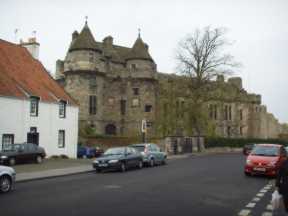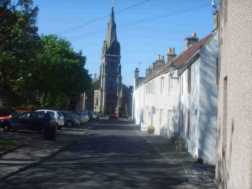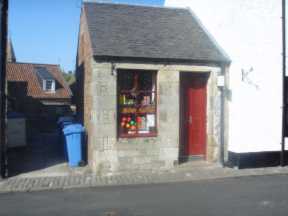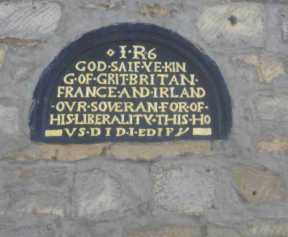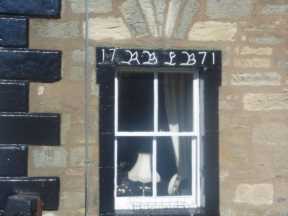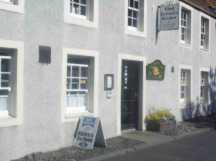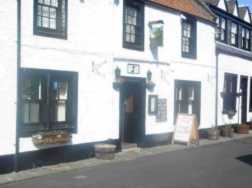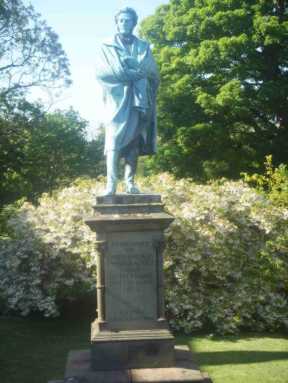
|
The History of Falkland Palace
May I also suggest you also check out the Things to do in Fife pages. It will help you with planning not only what to do in Falkland, but also I'm sure you'll find plenty of things for the whole family in and around the Kingdom.
Falkland Palace
Falkland Church
The Wee shop Falkland
Mary Queen of Scots was a frequent visitor, enjoying the peace and tranquility there and getting away from the problems and politics of Edinburgh. She enjoyed playing tennis, riding, hunting and hawking around Falkland. The Royal Tennis Court is reputed to be the oldest surviving Royal Tennis court of its kind in the world. A club still plays Royal (or Real) Tennis there today.
All around Falkland you’ll see signs of its Royal, industrial and social past in the buildings and streets. You’ll see the Marriage Lintels, the Burgh Crest, coats of arms, carvings and statues all have a story to tell.
Sign on house in Falkland
Sign above door in Falkland
Falkland’s fortunes were closely linked with the weaving of linen. In 1792 there were 231 weavers in the village, probably about a third of the population. Other buildings in the village reflect other phases of its history, and other industries including brewing. A walk around Falkland is a remarkable experience. Some of buildings simply ooze a deep and genuine history that takes some beating anywhere. At times it is difficult to know where to look. There are no fewer than 28 listed buildings in the village. In fact the history of Falkland just goes hand and hand with the history of Falkland Palace. The centre of the village is dominated by the palace gatehouse. But other fine buildings, many with towers of their own demand you show an interest in them. One of my favourites is the narrow cobbled wynd that looks seems almost unchanged over hundreds of years. And the Bruce Fountain in the Market Place is a central point and is used now almost as a roundabout.
One of the Tea Shops in Falkland
One of the Falkland Pubs
The Royal Palace of Falkland was the country residence of Stuart kings and queens when they hunted deer and wild boar in the local forest. Mary, Queen of Scots spent some of the happiest days of her tragic life here, ‘playing the country girl in the woods and parks’. The history of Falkland Palace goes back much earlier than the 16th century, but I just want to take you from that time. It was built between 1501 and 1541 by James IV and James V, replacing the earlier castle and palace buildings dating from the 12th century, traces of which can still be seen in the grounds. The roofed South Range contains the Chapel Royal, and the East Range the King’s Bedchamber and the Queen’s Room, both restored by the Trust. The Keeper’s Apartments in the Gatehouse are now also on display. The palace contains fine portraits of the Stuart monarchs and two sets of 17th-century tapestry hangings. It was James V completed the massive gatehouse, through which visitors access the Palace today, although James IV completed most of the adjoining facade of the building. This is the part of the Palace, which was restored in the 19th century by the Hereditary Keeper of the Palace, the 3rd Marquess of Bute. He refurbished the interior of the South Range, creating a comfortable home for himself. His son continued the good work by recreating a beautiful chapel, which had originally been built by James V. Only the external walls of the East Range are still standing and there is no trace left of the North Range.
Unfortunately, as in all National Trust for Scotland property, photography is not allowed inside, so I’m not able to show you some of these wonderful rooms. In addition to the Palace, there is a large and beautiful garden, full of well-manicured lawns, mature trees and colourful flowers. Even without the Palace, this would be worth a visit on it own merit. The garden, designed and built by Percy Cane between 1947 and 1952, contains three herbaceous borders enclosing a wide lawn with many varieties of shrubs and trees. Here also is the original Royal Tennis Court – the oldest in Britain still in use – built in 1539. There is also a small herb garden border featuring quotations from John Gerard’s book Herball (1597).
Statue of Onesiphorous Tyndall Bruce
For those interested in walking, the area has several superb walks. Those who have more energy than me may decide to climb to the top of the Lomond Hills. Its 424m summit is not high by Scottish standards, but the magnificent views will be reward for the climb. Of course other more gentle walks can be found closer to Falkland. Be sure to check out the Maps and Weather before you go climbing up the hills! From the hills you can see the towns of Auchtermuchty to the north and Glenrothes to the south. To learn more about other places and things to see and do, see also the following:- Maps and Weather - Find your way around and be prepared for the weather! Anstruther - Explore this lovely fishing village and treat yourself to some delicious Fish and Chips. Auchtermuchty - This lovely place (my home) is also home to a great Festival every year in August. Bridges - See the lovely and even awesome bridges that might be your way into the Enchanting Kingdom for things to see and do in Scotland! Glenrothes - Visit this New Town with all its amazing modern sculptures, or pop into the Markinch Highland Games. Kirkcaldy - The 'Lang Toun', one of the largest towns in Fife. St. Andrews - The 'Home' of golf, and the oldest University in Scotland, wonderful beaches, and the the history of St Andrew and the saltire. Pittenweem - Visit this scenic fishing village and home to Pittenweem Arts Festival. Dunfermline - The ancient capital of Scotland, a modern city, yet bulging with history of Kings and Queens, as well as the birthplace of Andrew Carnegie. Return from History of Falkland Palace to Things to see and do in Scotland
|
Available from Scotlands Enchanting Kindom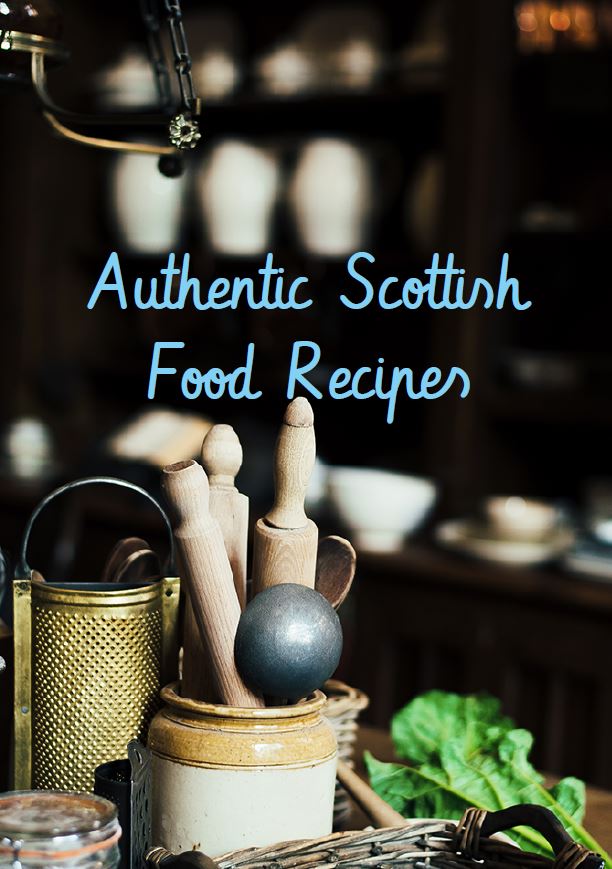
|
Contact Updates Home Page
See YOUR Advert on This Site
|
Text Box 1
Your Advert will appear in this column on a mutually agreed page, and will include Your Business Name, address, phone number and short description (maximum 30 words) and a link to your website and/or email address.
|
|
Text Box 2
This will be a larger box on the right-hand side of the page, and as well as including Your Business Name, Address, Phone number, and a link to your website and/or email address, it will also include a small image of your business and a maximum of 45 words description. |
|
Text Box 3
This option is for those who don't have their own website. When a visitor clicks on the link a new page will open with your details and a form for customers to contact you. The form will be sent to any email address you provide. You would send us a 2 - 3 paragraphs describing your business, your contact details and a photograph; and you would have your own page. |
|
Site search Web search |

